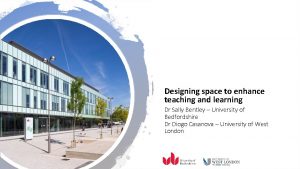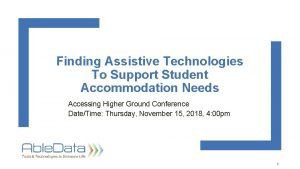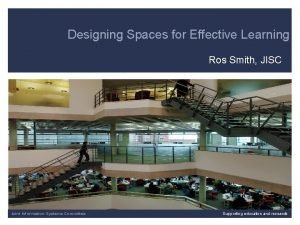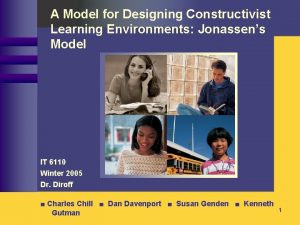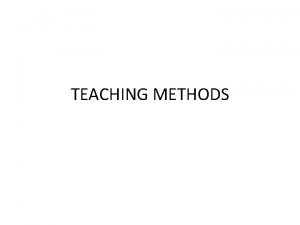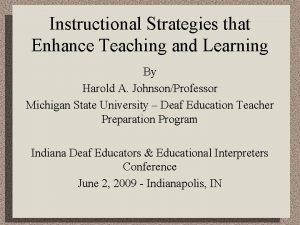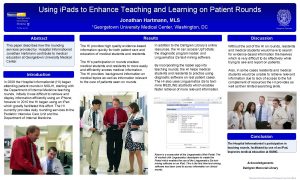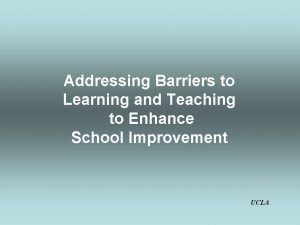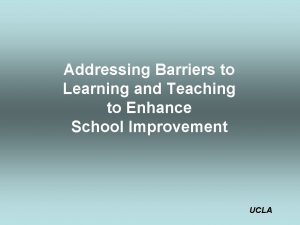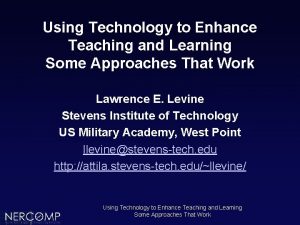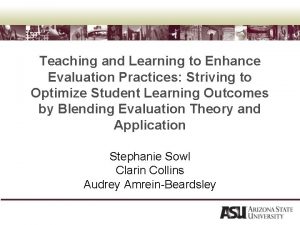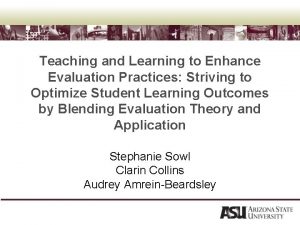Designing space to enhance teaching and learning Dr













- Slides: 13

Designing space to enhance teaching and learning Dr Sally Bentley – University of Bedfordshire Dr Diogo Casanova – University of West London

Background A lecture at the University of Bologna in Italy in the mid-fourteenth century. Lector - Latin for the one that reads Theatre - Greece for the beholding area

the evolution of learning spaces from ancient Greece to Current Classrooms Park & Choi, 2014

Yang et al. (2013) discuss the impact of classroom attributes (ambient, spatial, and technological attributes) on student satisfaction and performance 01 02 Ambience (color, temperature, light, acoustics) Furniture (tables, podium, chairs, whiteboards) 03 Layout and space (small or large, square, rounded, cabaret-style, row-byrow, horseshoe, debate, flexible? ) 04 05 Technology (tangible technology, projecting screens, Agency

Growing interest about learning spaces and how they may affect learners and learning experiences • Jessop, Gubby & Smith (2012) compare the perceptions of students and academics and conclude that space may re-inscribe hierarchical, teacher-centred approaches; • Park & Choi (2014) discuss the importance of changing room layout in order to promote more active learning (golden and shadow zone); • Radcliffe (2009) presents a framework for designing and evaluating learning spaces which integrates Pedagogy, Space and Technology as there key vectors referring that each influences the other in a dynamic force. Park & Choi (2014)

Scale-up Student-Centered Activities for Large Enrollment Undergraduate Programs First attempt to bring the benefits of collaborative and interactive learning to larger classrooms using technology in 1998 (Beichner, 2014; Beichner et al. , 2000)

Next Norwegian University of Science and Technology Next

New York University • Differently shaped tables • More screens to project on or more feeds • Smaller and more flexible podium • Further Whiteboards or scribble walls • Increase number of sockets • Flexible furniture University of Melbourne Trends in learning spaces design

Social learning in the Gateway

Classrooms in the Gateway • D Different height tables in Large round tables; stead of tiered lecture chairs on wheels; theatre; stools for high glass boards tables at back; tables on + Harvard ‘UN’ wheels allowing ‘conference style’ layout; debating chamber dividing doors with AV + Rectangular tables and chairs on wheels Trapezium tables designed for butting up against AV screens of facing front; chairs on wheels + Board rooms + Teaching IT suite Every room has a sign showing layout option and facts and figures

How are people using the Gateway? Positives Lost opportunities • Social learning – ground floor • Non-tiered lecture theatre • Round tables & chairs on wheels • Trapezium tables – misunderstood • AV screens for group work in social learning & classrooms – not used • Deconstructed ‘business pod’

Corridor In groups of 5 and using the space and the different tools provided Speaker Blank wall Projected image indow w Outside Speaker Podium • Identify what you would keep, lose or change in the space (10 min) - Use the post-its to write each input; • Using the exercise above try to redesign the space by sketching the group approach of a learning space. Use the provided pictures to help you in this design (10 min). Inside window

references • Brooks, D. C. (2014). Space and consequences: The impact of different formal learning spaces on instructor and student behavior. Journal of Learning Spaces, 1(2), 1– 13. • Jessop, T. , Gubby, L. , & Smith, A. (2012). Space frontiers for new pedagogies: a tale of constraints and possibilities. Studies in Higher Education, 37(2), 189– 202. doi: 10. 1080/03075079. 2010. 503270 • Park, E. , & Choi, B. (2014). Transformation of classroom spaces: traditional versus active learning classroom in colleges. Higher Education, 68(5), 749– 771. doi: 10. 1007/s 10734014 -9742 -0 • Yang, Z. , Becerik-Gerber, B. , & Mino, L. (2013). A study on student perceptions of higher education classrooms: Impact of classroom attributes on student satisfaction and performance. Building and Environment, 70, 171– 188. doi: 10. 1016/j. buildenv. 2013. 08. 030
 Cspnet
Cspnet Grammar to enrich and enhance writing
Grammar to enrich and enhance writing Define fashion merchandising
Define fashion merchandising Enhance an image
Enhance an image Cosmetics are substances that are used to enhance
Cosmetics are substances that are used to enhance Enhance an image
Enhance an image Nus grading system
Nus grading system Enhance life
Enhance life A salad that stimulates appetite
A salad that stimulates appetite Nnn hypnosis
Nnn hypnosis What is scaled down teaching
What is scaled down teaching Cuadro comparativo de e-learning b-learning y m-learning
Cuadro comparativo de e-learning b-learning y m-learning Designing spaces for effective learning
Designing spaces for effective learning Jonassen constructivism
Jonassen constructivism



